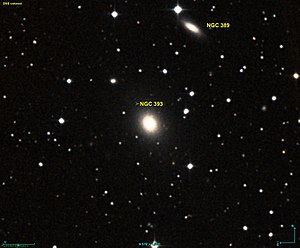NGC 393
| Galaxy NGC 393 |
|
|---|---|

|
|
| AladinLite | |
| Constellation | Andromeda |
|
Position equinox : J2000.0 , epoch : J2000.0 |
|
| Right ascension | 01 h 08 m 36.9 s |
| declination | + 39 ° 38 ′ 40 ″ |
| Appearance | |
| Morphological type | S0-: |
| Brightness (visual) | 12.4 mag |
| Brightness (B-band) | 13.4 mag |
| Angular expansion | 1.7 ′ × 1.4 ′ |
| Position angle | 29 ° |
| Surface brightness | 13.4 mag / arcmin² |
| Physical data | |
| Redshift | 0.020354 ± 0.000093 |
| Radial velocity | 6102 ± 28 km / s |
|
Stroke distance v rad / H 0 |
(280 ± 20) x 10 6 ly (85.8 ± 6.0) Mpc |
| history | |
| discovery | Wilhelm Herschel |
| Discovery date | October 5, 1784 |
| Catalog names | |
| NGC 393 • UGC 707 • PGC 4061 • CGCG 520-018 • MCG + 06-03-15 • 2MASX J01083695 + 393839 • GC 214 • H I 54 • h 88 • GALEX ASC J010836.87 + 393839.2 • LDCE 65 NED002 | |
NGC 393 is an elliptical galaxy of Hubble type E / S0 in the constellation Andromeda on the northern sky . It is estimated to be 280 million light years from the Milky Way and about 45,000 light years across.
In the same area of the sky is u. a. the galaxy NGC 389 .
The object was discovered on October 5, 1784 by the German-British astronomer Friedrich Wilhelm Herschel .
